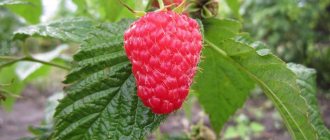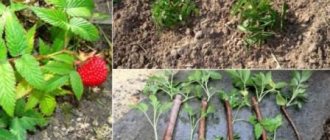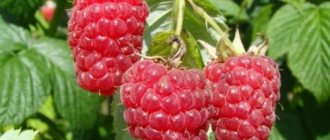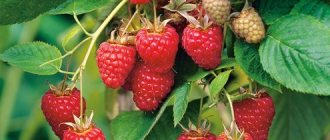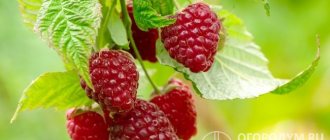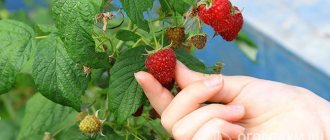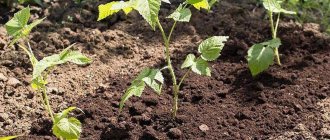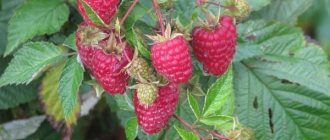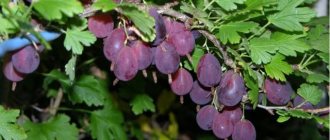Description of the raspberry variety Nizhegorodets
Today, choosing the right raspberry variety for your plot is not so easy. After all, breeders annually expand the range of crops. The raspberry variety Nizhegorodets, according to the description of the originators, is a medium-sized plant. The plant is unpretentious in care, high-yielding.
Bushes
The shoots are powerful, very spreading, slightly drooping, but they do not lie down due to the abundant harvest, since the flower stalks are located along the entire length of the stem.
The shoots of the second year of life bear fruit. They can be distinguished by their light brown color. The branches of the first year are initially light green, turning purple by autumn. The waxy coating is small, there is no pubescence.
Attention! The entire length of the Nizhny Novgorod raspberry shoots is covered with not too sharp thorns.
Each bush produces about 8 replacement shoots, which is enough for propagation. Since the root system of the Nizhny Novgorod raspberry is fibrous, the plant does not grow throughout the entire area.
Raspberry Nizhegorodets (as in the photo below) is distinguished by small, slightly wrinkled leaves of a dark green color. They are slightly curled, have denticles along the edges, and slight pubescence.
Berries
The fruits of the Nizhny Novgorod raspberry variety are large, the average weight is 12-20 g, the length is up to 3 cm. The wide-conical berries with a pointed tip consist of homogeneous drupes interlocked tightly, so the fruits do not crumble when picked. According to gardeners, 5-6 Nizhny Novgorod raspberries fit in the palm of your hand.
By the time they ripen, the berries acquire a beautiful ruby color with a lacquered sheen. The fruits are juicy, dense, sweet and sour, with a real raspberry aroma.
Important! The hotter the summer, the richer the taste of the berries of this variety.
The variety is recommended by its originators for cultivation in central Russia. Today, the geography of Nizhny Novgorod raspberries has expanded significantly; bushes can be found much further north.
Reproduction of the Nizhegorodets variety
In terms of propagation, Nizhny Novgorod raspberries are far from ideal, because... produces very little growth. However, this negative feature is inherent in most varieties of remontant raspberries.
For propagation, you can use root or green cuttings.
Characteristics of the variety
The description does not fully reveal the characteristic features of cultivated plants. Gardeners who decide to expand the range of raspberry bushes on their site are interested in:
- how does a plant bear fruit?
- under what conditions can it grow?
- what advantages and disadvantages it has;
- Is it affected by pests and insects?
Drought resistance, frost resistance
The remontant raspberry variety Nizhny Novgorod is drought-resistant, which attracts gardeners who cannot often come to their dacha. Winter hardiness is high; it overwinters well at temperatures of -30 degrees. At lower rates, it needs shelter.
Productivity and fruiting
Fruiting of the Nizhegorodets variety is extended: the first berries ripen at the end of June, harvesting continues until the first frost. From 1 bush, subject to agricultural technology and good weather conditions, 6-8 kg of large, sour fruits are harvested.
The berries do not fall off even if they are overripe and do not lose their presentation. They can hang on fruiting branches for 2 weeks.
Area of application of fruits
Raspberry variety Nizhny Novgorod for universal use. Few people will refuse to taste fresh fruits. Berries suitable for cooking:
- compotes;
- jam;
- jams;
- juices
Frozen raspberries retain their taste and beneficial properties.
Farmers also paid attention to the Nizhegorodets raspberry variety. The berries do not wrinkle or flow during transportation, since the fruit is torn off dry. So the transportability of raspberries is high. The berries are stored in the refrigerator for up to 2 weeks.
Resistance to diseases and pests
According to gardeners, the remontant raspberry variety Nizhegorodets is resistant to fungal diseases. Rarely affected by raspberry mite. As for other diseases and pests, it is necessary to apply preventive measures.
Advantages and disadvantages of the variety
Raspberries (like any plant) have both positive and negative sides. When choosing a new variety, gardeners focus on its merits.
Advantages of remontant raspberries of the Nizhegorodets variety:
- High and stable yield every year.
- Almost instantaneous ripening of fruits.
- You can get 2 harvests a year: on last year’s shoots, which were covered for the winter - early berry picking. On shoots mown in autumn, the fruits are harvested in late July - early August.
- The berries do not bake in the sun and do not fall off when fully ripe.
- Taste and commercial qualities are not lost during storage and transportation.
- Nizhny Novgorod raspberry bushes are unpretentious in care.
- The variety is drought and frost resistant.
- There are thorns, but they are non-aggressive and do not interfere with harvesting and caring for bushes.
Unfortunately, despite the large number of advantages, Nizhny Novgorod has some disadvantages:
- Depending on the characteristics of summer, the taste of the berries may change. Heavy rainfall makes the berries sour.
- In regions where frosts begin early, some fruits do not have time to ripen.
- Raspberry shoots of the Nizhny Novgorod variety require tying.
a brief description of
The variety has much more advantages, but there are also disadvantages. However, judging by the reviews of gardeners, we can say with confidence that this is one of the best remontant raspberry varieties.
Advantages of the variety
- unpretentiousness to environmental conditions, endurance to heat and cold;
- good transportability of berries;
- berries are uniform, large;
- the crop does not fall off for a long time, even when fully ripe;
- resistance to raspberry mites and fungal diseases.
Disadvantages of the variety
- strong dependence of the size and taste of fruits on cultivation conditions;
- the need to arrange trellises;
- abundance of thorns;
- in the northern regions of Russia it does not have time to fully ripen.
Perhaps Nizhny Novgorod is not the ideal variety that many summer residents dream about, however, its advantages outweigh its disadvantages. This raspberry will be convenient for those gardeners who come to the garden only on weekends, because... a ripe berry will not fall off and will wait for its owner. The variety is well adapted to the conditions of central Russia, but can also find application in more severe agroclimatic conditions, for example, in the Urals and Siberia.
Landing Features
When planting remontant raspberries from Nizhny Novgorod, no special rules are required. All events are exactly the same:
- site selection and soil preparation;
- digging holes or trenches;
- filling the seats with drainage and soil;
- preparation of seedlings;
- watering and mulching.
The depth of the holes is at least 40-50 cm, the width is from 40 cm, at least 50-60 cm is left between the bushes. When planting plants in several rows, the distance between them is made in increments of 1.5-1.8 m.
Recommended timing
The Nizhegorodets variety can be planted in spring or autumn. For autumn propagation, planting pits are prepared 2-3 months before planting. The soil is dug up and sown with green manure.
If seedlings are planted in the spring, which is usually the end of April, then the holes or trenches need to be filled in the fall. Planting is carried out before the first frost.
Important! Residents of the Northern regions need to plant Nizhegorodets raspberries in the spring, since in winter the fragile root system freezes even under cover.
Choosing a suitable location
For all varieties of crops, including Nizhny Novgorod raspberries, choose a well-lit place where there are no drafts. Groundwater should not be higher than 1.5 m, despite the fact that the plant is moisture-loving. Places where precipitation lingers are also not suitable.
Advice! You should not plant raspberries next to potato and strawberry plantings, as these plants can cause diseases and pest invasions.
Selection and preparation of planting material
The quality of planting material must be taken seriously. What to pay attention to:
- the stem should be from 0.7 to 1 cm thick, 30-40 cm high;
- shoot color – light green;
- The root system, as well as the shoots, should be free of damage and signs of infection by diseases and pests.
Before planting, seedlings with an open root system are soaked for a day in a solution of potassium permanganate. Immediately before placing the bush in the hole, the root is dipped into a clay-manure mash.
Landing algorithm
Stages of work:
- Drainage is laid at the bottom of the hole or trench: broken brick, crushed stone, wood chips, tree bark, weeds picked from the garden.
- The soil removed from the holes is mixed with humus, peat or compost, and wood ash. A layer of fertile soil is placed in a hole and watered so that the soil seeps to the very bottom and there are no voids left.
- Fill the soil almost to the top, install the seedling, having first straightened the root system.
- Fill in the remaining soil, compact it lightly and water generously.
Attention! To keep the moisture longer, the surface around the raspberry bushes is mulched with humus, compost, sawdust or dry straw.
Growing and care
The set of measures for caring for Nizhny Novgorod raspberries is not complicated, but it cannot be said that the variety is ideal in this regard. Spreading, tall bushes require trellises. The simplest version of a trellis consists of supports that are driven in at intervals of 3-6 m and rows of wire that are located at a height of 0.5, 1, 1.5 m from the soil surface.
Nizhny Novgorod raspberries need timely irrigation. When watering, it is important to take into account that, on the one hand, you cannot allow water to stagnate, and on the other, you need to saturate the soil to the depth of the bulk of the roots (30-35 cm). The average water consumption when watering is 2 buckets per bush, frequency: once a week. If during the period of flowering and the beginning of fruit formation there is dry, hot weather, then the frequency of watering can be increased and watering should be done once every 5 days. Mulching will allow you to reduce watering. It is best to arrange drip irrigation, which will ensure uniform saturation of the soil and save water.
Nizhny Novgorod raspberries are pruned in one of the following ways:
- following the example of simple summer raspberries, when two-year-old shoots are completely removed in the fall, and annual shoots are left for the winter;
- complete autumn pruning of absolutely all shoots.
Pruning using the second method simplifies the process of preparing shrubs for winter and reduces the risk of pests and diseases, because the entire above-ground part is taken outside the raspberry patch and burned.
Applying fertilizers during planting will allow you not to worry about soil fertility over the next two years. Then you will have to feed the soil annually. Superphosphate or nitroammophoska in a volume of 40 to 100 g per square meter is suitable as a complex fertilizer. Potassium magnesia can be used as a potassium supplement in an amount of 20 - 40 g m2
The most potent fertilizer for this variety is liquid organic matter. It is best to use mullein solution as it. It will be necessary to apply fertilizer 2 to 3 times during the growing season. In this case, from 3 to 5 liters are used. per 1 m2, diluted in a ratio of 1:15 fertilizer.
Preparing for winter
In order for raspberries to survive the cold season well, it is best to completely trim all shoots. Pruning is done at ground level; stumps are not left, because they can serve as a “winter house” for pests and become a source of infections when rotting.
After pruning the bushes, it is necessary to apply organic fertilizers to the raspberries and loosen the soil to a shallow depth so as not to damage the roots.
Pruning is the main and decisive stage of preparation for winter, but not the only one. It is worth thinking about the cold period even before choosing a site, because it must be protected from the wind and be as accessible as possible to sunlight. Also, an autumn overdose of nitrogen fertilizers should not be allowed, because it will significantly reduce frost resistance.
If you decide to grow Nizhny Novgorod according to the example of ordinary summer raspberries, then the shoots remaining for the winter must be bent to the ground so that in winter they are covered with snow. To do this, the stems need to be cleared of foliage, and then tilted one on top of the other and secured with the bottom wire of the trellis. The described procedure must be done before the cold weather becomes stable, until the stems lose their flexibility.
Aftercare
Further care for planting raspberries of the Nizhegorodets variety, according to reviews, is simple. The only inconvenience is tying up the shoots, since the bushes are spreading. They are usually attached to a trellis. The rows of wire are spaced at a distance:
- 50 cm;
- 1m;
- 1.5 m.
Shoots are tied to it.
Watering
Despite its drought resistance, the remontant variety Nizhegorodets must be watered in a timely manner. If it rains regularly, no irrigation is carried out. The main thing is that the moisture goes to a depth of 30-35 cm. In dry summers, 2 buckets of water are poured onto each bush every 7-10 days. The surface must be mulched and weeds removed.
Top dressing
If nutritious soil was used during planting, then there is no need to feed the raspberries for 2 years. In the future, you can use mineral complex fertilizers (if the gardener is a follower of chemistry) or organic matter.
Raspberries of any variety respond well to feeding with mullein, chicken droppings, and infusion of green grass. It is useful to sprinkle the bushes themselves and the ground around the bushes with dry wood ash.
Advice! Any fertilizing is carried out on well-moistened soil.
Trimming
There are different options for pruning remontant raspberries from Nizhny Novgorod:
- sanitary;
- pinching annual shoots if they are not cut out for the winter;
- complete cutting of stems before wintering.
Cut parts of the plant must be burned.
Attention! Cutting out all shoots for the winter is an excellent prevention of diseases and pests.
Preparing for winter
Actions:
- After harvesting, water-recharging irrigation is carried out.
- The shoots of remontant Nizhny Novgorod raspberries are cut out at the root (there should be no stumps!) and the soil is treated with Bordeaux mixture.
- Sprinkle the top with a layer of mulch of at least 10 cm.
- More severe conditions require more extensive cover.
If the shoots are left for next year, they should be bent before frost, while they are still bending. The stems are fixed with staples. Next, cover the plantings in the usual way.
Harvesting and transportation
Nizhny Novgorod berries begin to ripen in the last week of July and fruiting continues until the onset of stable frosts. The fruits ripen simultaneously, stay on the stalks for a long time, and do not fall off for two weeks.
The berries are picked as they ripen along with the stalk and placed in a small plastic or wooden container . Raspberries have a dense structure, do not flow or deform during transportation. It is distinguished by its keeping quality. Can be stored in a refrigerator for several weeks without loss of presentation and taste. The berries are characterized by versatility, excellent for fresh consumption, for preparing winter preparations, compotes, and freezing.
Did you know? Raspberries were first cultivated in the 16th century. At the same time, the crop began to be divided into varieties.
Raspberry Nizhny Novgorod is a favorite among domestic gardeners. It is undemanding in care, has excellent drought and winter resistance, strong immunity, stable fruiting and amazing fruit quality. The berries of the described variety have a high commercial value, can be transported over long distances and stored for more than 10 days.
Diseases and pests, methods of control and prevention
Since the variety is resistant to many diseases and pests, most often when caring for plantings, preventive measures are taken:
- spraying bushes at the first signs of diseases and the appearance of pests;
- weeds should not be allowed to grow;
- timely sanitary pruning and removal of excess young shoots.
For prevention, twice a year (before flowering and after picking berries), you need to spray raspberries with Bordeaux mixture.
For the destruction of insects and disease spores, excellent means are:
- "Fitoverm";
- "Poliversum VP";
- "Nitrafen";
- "Fitosporin".
Proper care of raspberries ensures an excellent harvest.
Features of the Samokhval variety
Raspberry Samokhval, or Nizhegorodets 2, is a completely new remontant variety of Russian selection, obtained by crossing Karamelka and Nizhegorodets.
Samokhval was bred in the Nizhny Novgorod nursery Shkolny Sad, the originator is V. A. Shiblev. Included in the State Register of the Russian Federation only in 2021. Find out more about the benefits and harms of raspberries.
Description
The bush is of medium power and strength, moderately spreading, drooping type. One-year shoots can reach a height of 1.3–1.5 m, depending on the region, timing and growing conditions. In the description of the variety, the originator indicates that Samokhval is lower than his ancestors.
One-year-old stems are light brown in color and slightly covered with a waxy coating. The base of the spines is purple in color, the tips are curved down, not very pointed. Most of the thorns are located at the bottom of the raspberry bush. The large leaves are slightly curled and the edges are jagged. There are many side branches, they are sparsely pubescent and quite strongly developed.
The variety is characterized by well-developed shoot replacement, increasing in the second or third season. The berries have an average weight of 6 to 9 g. According to some gardeners, using progressive agricultural techniques, it is possible to grow a crop with a fairly large number of very large berries - up to 20 g.
The fruits are cone-shaped and regular in shape; during the period of technical ripeness, they are glossy and scarlet in color (see photo). By the time of consumer maturity, the color becomes less bright and a ruby tint appears.
Did you know? Russia grows about 150 thousand tons of raspberries per year, being the largest producer of the crop in the world. The top five also includes the USA, Serbia, Germany and Poland.
The drupes of the fruit are tightly connected to each other, which makes the pulp quite dense, but it is also very juicy. The raspberries in question have excellent taste, which, according to experts, is 4.2–4.5 points.
Chemical composition of berries:
- sugar - 7.2%;
- acid - 1.3%;
- vitamin C - 56 mg/100 g.
Characteristic
The described variety has an average ripening period - in the central regions of Russia, the harvest can be harvested in the second half of August - in the first half of September. The yield, according to the breeder developers, is high: it can reach up to 18 t/ha, up to 8 kg of berries can be collected from one bush. According to unverified data, in the technical ripeness phase, the crop can be harvested using a mechanized method.
It does not have a pronounced predisposition to major diseases, although nothing is known about any special resistance to certain diseases. The developers of Nizhegorodets 2 and gardeners with experience in growing the variety claim that it has good winter hardiness.
Planting seedlings
Nizhny Novgorod raspberries bear fruit well in light, nutritious, moderately moist soils. The culture is very demanding on lighting.
Spring planting
The plot for raspberries of the Nizhny Novgorod variety begins to be prepared in the fall. The soil is thoroughly cleared of weeds and dug deeply. At this stage, the soil should be well fertilized: 2-3 buckets of peat, one glass each of superphosphate and potassium sulfate (or 200-300 g of complex inorganic fertilizers) are added per square meter of area.
Landing
To begin with, you should consider two important factors in obtaining high results from any raspberry variety:
- good lighting;
- light, moderately moist soil with plenty of nutrients.
It is equally important to choose quality seedlings. The thickness of the stem at the base should be within 0.7-1 cm, length 30 - 40 cm. The seedling should not have signs of disease or mechanical damage. The root system should also be well developed.
Planting raspberries can occur both in spring and autumn. In the first case, preparation begins in the autumn, the soil is cleared of weeds and dug up. It is important to thoroughly fertilize the soil by adding inorganic complex fertilizers, as well as compost or rotted manure, and ash.
In the second half of April it is necessary to dig holes. Their depth should be within 40-50 cm, and the width and length should be about 40 cm. Row spacing should reach 1.5...1.8 m, the distance between bushes should be 65-70 cm.
Read also: Benefits of feijoa for a woman’s body reviews
Raspberry seedlings are lowered into moistened holes. The roots of the shoot are carefully straightened and covered with earth. It is important to remember that the root collar should remain flush with the soil surface and there should be no soil on it. The shoots are cut at a height of about 20 cm and watered with water. The soil in the raspberry patch is mulched. Mulch prevents the soil from drying out, maintains its breathability, overheats, and serves as a source of nutrients.
If planting is planned for autumn, then soil preparation is carried out in the spring. In the area where the raspberries will be, green manure crops are sown, for example, lupine, rye or mustard. A month before the planned planting of raspberries, green manure is dug up.
Nizhny Novgorod raspberries will take root well if planted a month before the first frost. In the middle zone you can start already at the beginning of September. In the southern parts of Russia this is approximately mid-September - early October. But in the north it is not recommended to plant this variety in the fall; there is a high risk of damage to fragile young plants by frost.
Description of raspberries Pride of Russia
Raspberry bushes of the Pride of Russia variety have average (not higher than 1.8 m) growth. At the same time, the bush itself takes up relatively little space, since it is not very spreading. Up to a dozen shoots and about half as many root shoots are formed on the bush.
Each stem lasts about two years, after which it dries out. Annual green shoots have a rosette of leaves at the top. At the same time, they are pubescent and do not have a waxy coating. The shoots of the second year of life are brown, they are denser and they do not have leaves near the growth cone. Both one-year and two-year stems are thornless. The leaves of the plant are large and bright green in color.
Each fruiting branch of the Pride of Russia raspberry can produce more than two dozen large berries. Their weight is quite large and ranges from 10 to 12 g. In rare cases, the size of the berries is average - from 4 to 8 g. The berries have the shape of an elongated cone. A distinctive feature of the Pride of Russia raspberry is its strong contact with the core of the fruit. Even fully ripe berries do not crumble or come off.
Important! The raspberry variety Pride of Russia, due to the large number of shoots and offspring, has a high growth rate. If the growth of raspberries of this variety is not restrained, they can spread very quickly throughout the entire garden plot.. Initially, raspberries were created for the climatic zone of the Moscow region
However, due to its good frost tolerance, the variety’s cultivation area is expanding to all areas belonging to the fifth frost resistance zone.
Initially, raspberries were created for the climatic zone of the Moscow region. However, due to its good frost tolerance, the variety’s cultivation area is expanding to all areas belonging to the fifth frost resistance zone.
A sample of the Pride of Russia raspberry bush is shown in the following photo:
Description of Nizhny Novgorod: characteristics from the originator, assessment of breeders
Brief characteristics based on testing, description – short, succinct, reliable.
The beginning of ripening is the second ten days of August, the middle of the month, it produces the autumn harvest until the beginning of mid-August. Ripening and coloring are simultaneous and friendly.
The industrial yield is declared to be 185 c/ha, or 15-19 t/ha. According to Gossort, 183 c/ha. According to estimates of the autumn harvest, productivity in the conditions of central Russia is from 2 kg to 2.5 or more. In the conditions of the Moscow region and the middle zone, the potential yield is realized by 80-100%, depending on the year.
- A bush of medium height, with a highly spreading habit, drooping shoots, medium thickness, fruiting zone of about 50% of the height.
- The shoot-forming capacity is very high - about 7-8 replacement shoots, which is considered above average. The shoots droop under the weight of the fruit - they need support.
- Annuals are light green, covered with purple crimson by August-September, with a slight waxy coating, without pubescence, with spines; biennials are light brown with a purple tint.
- The thorns are light purple with a green base, straight, slightly inclined downwards, sharp, hard, located along the entire length of the stem, thicker at the base and less frequent at the apex.
- The leaf is slightly wrinkled, slightly pubescent, of medium size, slightly twisted, intense green (dark green). The edge is serrated, the teeth are medium-sharp. Fruit branches with weak pubescence, covered with a light waxy coating.
- The berries have an intense shine, slight pubescence, an average weight of 5-6 g, the largest specimens reach a record size and weight of 12.3 g.
- The shape is broadly conical (according to other estimates, closer to rounded-conical), the color is dark red (dark crimson). The drupes are homogeneous, well executed, firmly adhered.
- In comparison with the Bryansk diva, it is larger, while, according to the review, the load and shoot with fruits is about 2-2.5 times less.
- The berry is very large, bright ruby when fully ripe, dense, dry, regular in shape, size remains virtually unchanged until the end of the harvest.
- The taste is pleasant, sweet and sour with characteristic raspberry notes, more intense when fully ripe, in sunny, warm weather.
High resistance to fungal diseases, low susceptibility to raspberry mites. Heat resistance is average, drought resistance is high.
- Huge without exaggeration, beautiful, correct, one-dimensional, not shrinking, excellent presentation and good density - dry, does not flow, does not wrinkle, weighs for a long time without crumbling.
- Early ripening with a one-year growing cycle, with autumn mowing of shoots, almost complete realization of productivity - 80-100%.
- Uniform coloring of fruits, simultaneous ripening.
- Relative unpretentiousness in the conditions of Central Russia - drought resistance, heat resistance at the level of cultural standards.
- It does not bake in the sun, does not cook, perhaps due to its high density - gardeners comment on its undoubted advantage. Frost resistance is sufficient, with rare isolated cases of freezing in the northern zones.
- The thorns are not aggressive and do not interfere with planting or harvesting.
Price size or not without unpleasant moments
Not entirely unpleasant - all rhemas are guilty of them, but it is important to know about them
- Among the disadvantages are inclined shoots, bending to the ground under the weight of fruits, requiring garter.
- Those looking for true summer sweetness and a multifaceted bouquet note the superiority of many summer varieties, and not only over the taste of Nizhny Novgorod.
- The tasting score of 4 points speaks for itself - there are better ones, but there are not many of them, especially among remontants.
- According to reviews, when fully ripe it gains sweetness and versatility. The taste is sour, it is simple in the northern zones, in too cold autumn.
And also - in the cool autumn, the rainy taste is rustic, sour - the eternal drawback of autumn raspberries - experienced berry growers complain. With early frosts, it will not ripen 100% in the Nizhny Novgorod region, Moscow region - but you can count on 80%.
Planting at a distance of 0.7-1 m to 1.5 m between plants, 2-2.5 m between bushes and up to 3 m if there is free space
With thickened plantings, attention should be paid to increasing the removal of nutrients
- Needs a garter - arrange trellises with two or three rows.
- Given the high need for fertilizing, the removal of nutrients is greater compared to a summer crop, and requires a carefully designed nutritional plan to obtain maximum benefit.
- At the initial phase of the growing season it needs a larger share of nitrogen, at the flowering phase – up to – microelements, potassium, phosphorus, iron, manganese, boron, etc.
Reviews
The berries are large, the yield is high, but I don’t really like the taste, the berry is quite sour and very watery. I’ll immediately make a reservation that I couldn’t give the raspberries a sunny area and in terms of providing nutrients, not everything is going smoothly for me, maybe that’s why the taste suffers, however, summer raspberries grow nearby and they are sweeter.
I have been growing Nizhny Novgorod for sale for several years. Its fruits are always smooth, large, and dense. Transportability and keeping quality are good. I sell the part of the harvest that I don’t have time to sell on the day of harvest the next day, but this is not noticeable at all from the appearance of the berries.
In conclusion, it is worth noting that the remontant raspberry variety Nizhegorodets has all the qualities to be among the most advanced raspberry varieties today. At the same time, it still does not reach the ideal, and breeders still have some work to do.

